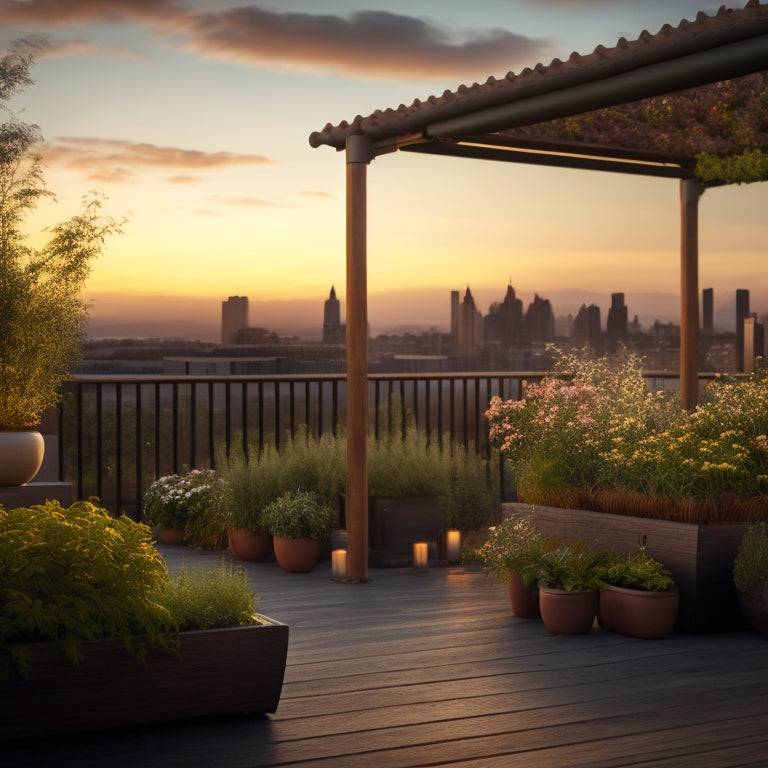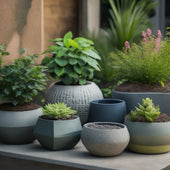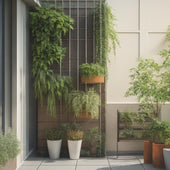
3 Essential Rooftop Vegetable Garden Layouts
Share
You can create a rooftop oasis with three essential vegetable garden layouts. First, maximize space with vertical gardens by training vining plants like peas and tomatoes to climb up trellises or arbors. Next, envision a vibrant tapestry of pots and planters bursting with fruits, vegetables, and herbs in a productive container garden layout. Finally, appreciate the convenience of rooftop beds for easy access, providing raised planters and elevated platforms that reduce strain on your back and knees. Each layout offers a unique solution to transform your rooftop, and by exploring these options, you'll uncover the perfect blend of style, functionality, and harvest.
Key Takeaways
• Train vining plants like peas, beans, and tomatoes to climb up trellises or arbors to maximize space in rooftop gardens.
• Create a productive vertical garden on rooftops using a space-saving solution that incorporates flowering vines for color and fragrance.
• Use containers with good drainage and well-balanced soil composition to grow a vibrant tapestry of fruits, vegetables, and herbs.
• Incorporate raised planters and elevated platforms to provide easy access to vegetables and reduce strain on back and knees.
• Employ efficient watering techniques like soaker hoses and drip irrigation to conserve water and reduce maintenance.
Maximizing Space With Vertical Gardens
By training vining plants like peas, beans, and tomatoes to climb up trellises or arbors, you can create a lush, productive vertical garden that makes the most of your rooftop's available space. This vertical planting technique is a space-saving solution that not only maximizes your rooftop's real estate but also adds visual appeal.
Imagine a DIY trellis structure adorned with a tapestry of greenery, providing shade and beauty to your rooftop oasis.
When selecting plants for your vertical garden, choose varieties that naturally climb or have a vining habit. You can also incorporate flowering vines like clematis or wisteria to add color and fragrance.
Consider building a DIY trellis using wooden or metal frames, or repurpose an old fence or gate to create a unique structure. Train your plants to grow up the trellis using twine, wire, or clips, and provide support as they grow.
With a little creativity and planning, your rooftop can become a thriving vertical garden, teeming with life and bounty.
Productive Container Garden Layout
When designing a productive container garden layout, envision a vibrant tapestry of pots and planters, each one bursting with a diverse array of fruits, vegetables, and herbs, carefully arranged to maximize space and visual appeal.
You can create a thriving oasis on your rooftop by selecting containers with good drainage and a well-balanced soil composition that suits your plants' needs. Consider using a mix specifically designed for containers, which will retain moisture but also drain excess water.
As you arrange your containers, think about the mature size of each plant and leave enough space for air circulation and easy access for watering and harvesting.
Speaking of watering, employing efficient watering techniques is crucial to conserve this precious resource. Use soaker hoses or drip irrigation to deliver water directly to the roots, reducing evaporation and runoff.
You can also incorporate self-watering containers or planters with built-in water reservoirs to minimize maintenance.
Rooftop Beds for Easy Access
You'll appreciate the convenience of rooftop beds, which allow you to tend to your vegetables without straining your back or knees, as you can easily reach across the bed to plant, weed, or harvest. This is especially important if you have mobility issues or simply want to make gardening more enjoyable. Raised planters and elevated platforms are great options for rooftop beds, providing easy access to your vegetables.
Here are some benefits of rooftop beds for easy access:
| Feature | Benefit | Tips |
|---|---|---|
| Elevated Platform | Reduces strain on back and knees | Use a platform with a comfortable working height |
| Raised Planter | Improves accessibility | Choose a planter with a wide, flat surface |
| Compact Design | Saves space | Consider a rectangular or square shape |
| Modular System | Allows for customization | Mix and match modules to fit your needs |
Frequently Asked Questions
How Much Weight Can a Typical Rooftop Support for a Garden?
You're building a rooftop oasis, and it's as delicate as a house of cards - one wrong move, and it all comes crashing down. Typically, a rooftop can support 10-20 pounds per square foot, but you must consider structural considerations, ensuring your garden's weight capacity harmonizes with the rooftop's strength.
Can I Use a Rooftop Garden for Outdoor Dining and Entertainment?
You can create an inviting outdoor dining space on your rooftop, blending garden aesthetics with functional seating areas, where you'll love hosting friends and family amidst lush greenery and vibrant blooms.
Are Rooftop Gardens Susceptible to Strong Winds and Storms?
'You'll want to wisely weatherize your rooftop haven, as fierce gusts and torrential rains can wreak havoc. Guarantee wind protection and prevent storm damage by securing planters, reinforcing structures, and prioritizing garden safety and structural integrity.'
How Do I Ensure Adequate Drainage in a Rooftop Garden?
To guarantee adequate drainage in your rooftop garden, you'll want to balance water retention with soil composition, consider plant spacing for proper sunlight exposure, and incorporate features like French drains or raised beds to prevent waterlogged soil.
Can I Install a Rooftop Garden on a Sloping or Curved Roof?
Just like a surfer riding a gnarly wave, you're wondering if you can tame a sloping or curved roof to create a thriving garden oasis. Yes, you can, but be prepared to navigate a steep slope or curved surface with specialized design and materials.
Related Posts
-

How Much Do Concrete Planters Weigh
When creating a concrete planter, you'll need to take into account the weight implications of your design. The type a...
-

How Much Do Concrete Planters Weigh
When creating a concrete planter, you'll need to take into account the weight implications of your design. The type a...
-

How Much Do Concrete Planters Weigh
When creating a concrete planter, you'll need to take into account the weight implications of your design. The type a...
-

How Much Do Concrete Planters Weigh
When creating a concrete planter, you'll need to take into account the weight implications of your design. The type a...
-

How Much Do Concrete Planters Weigh
When creating a concrete planter, you'll need to take into account the weight implications of your design. The type a...
-

How Much Do Concrete Planters Weigh
When creating a concrete planter, you'll need to take into account the weight implications of your design. The type a...
-

How Much Do Concrete Planters Weigh
When creating a concrete planter, you'll need to take into account the weight implications of your design. The type a...
-

How Much Do Concrete Planters Weigh
When creating a concrete planter, you'll need to take into account the weight implications of your design. The type a...
-

How Much Do Concrete Planters Weigh
When creating a concrete planter, you'll need to take into account the weight implications of your design. The type a...
-

How Much Do Concrete Planters Weigh
When creating a concrete planter, you'll need to take into account the weight implications of your design. The type a...
-

How Much Do Concrete Planters Weigh
When creating a concrete planter, you'll need to take into account the weight implications of your design. The type a...
-

How Much Do Concrete Planters Weigh
When creating a concrete planter, you'll need to take into account the weight implications of your design. The type a...
-

How Much Do Concrete Planters Weigh
When creating a concrete planter, you'll need to take into account the weight implications of your design. The type a...
-

How Much Do Concrete Planters Weigh
When creating a concrete planter, you'll need to take into account the weight implications of your design. The type a...
-

How Much Do Concrete Planters Weigh
When creating a concrete planter, you'll need to take into account the weight implications of your design. The type a...
-

How Much Do Concrete Planters Weigh
When creating a concrete planter, you'll need to take into account the weight implications of your design. The type a...
-

How Much Do Concrete Planters Weigh
When creating a concrete planter, you'll need to take into account the weight implications of your design. The type a...
-

How Much Do Concrete Planters Weigh
When creating a concrete planter, you'll need to take into account the weight implications of your design. The type a...
-

How Much Do Concrete Planters Weigh
When creating a concrete planter, you'll need to take into account the weight implications of your design. The type a...
-

How Much Do Concrete Planters Weigh
When creating a concrete planter, you'll need to take into account the weight implications of your design. The type a...
-

How Much Do Concrete Planters Weigh
When creating a concrete planter, you'll need to take into account the weight implications of your design. The type a...
-

How Much Do Concrete Planters Weigh
When creating a concrete planter, you'll need to take into account the weight implications of your design. The type a...
-

How Much Do Concrete Planters Weigh
When creating a concrete planter, you'll need to take into account the weight implications of your design. The type a...
-

How Much Do Concrete Planters Weigh
When creating a concrete planter, you'll need to take into account the weight implications of your design. The type a...
-

How Much Do Concrete Planters Weigh
When creating a concrete planter, you'll need to take into account the weight implications of your design. The type a...
-

How Much Do Concrete Planters Weigh
When creating a concrete planter, you'll need to take into account the weight implications of your design. The type a...
-

How Much Do Concrete Planters Weigh
When creating a concrete planter, you'll need to take into account the weight implications of your design. The type a...
-

How Much Do Concrete Planters Weigh
When creating a concrete planter, you'll need to take into account the weight implications of your design. The type a...
-

How Much Do Concrete Planters Weigh
When creating a concrete planter, you'll need to take into account the weight implications of your design. The type a...
-

5 Best DIY Planter Ideas to Upcycle Concrete
You're about to breathe new life into discarded concrete blocks by transforming them into functional and visually app...
-

5 Best DIY Planter Ideas to Upcycle Concrete
You're about to breathe new life into discarded concrete blocks by transforming them into functional and visually app...
-

5 Best DIY Planter Ideas to Upcycle Concrete
You're about to breathe new life into discarded concrete blocks by transforming them into functional and visually app...
-

5 Best DIY Planter Ideas to Upcycle Concrete
You're about to breathe new life into discarded concrete blocks by transforming them into functional and visually app...
-

5 Best DIY Planter Ideas to Upcycle Concrete
You're about to breathe new life into discarded concrete blocks by transforming them into functional and visually app...
-

5 Best DIY Planter Ideas to Upcycle Concrete
You're about to breathe new life into discarded concrete blocks by transforming them into functional and visually app...
-

5 Best DIY Planter Ideas to Upcycle Concrete
You're about to breathe new life into discarded concrete blocks by transforming them into functional and visually app...
-

5 Best DIY Planter Ideas to Upcycle Concrete
You're about to breathe new life into discarded concrete blocks by transforming them into functional and visually app...
-

5 Best DIY Planter Ideas to Upcycle Concrete
You're about to breathe new life into discarded concrete blocks by transforming them into functional and visually app...
-

5 Best DIY Planter Ideas to Upcycle Concrete
You're about to breathe new life into discarded concrete blocks by transforming them into functional and visually app...
-

5 Best DIY Planter Ideas to Upcycle Concrete
You're about to breathe new life into discarded concrete blocks by transforming them into functional and visually app...
-

5 Best DIY Planter Ideas to Upcycle Concrete
You're about to breathe new life into discarded concrete blocks by transforming them into functional and visually app...
-

5 Best DIY Planter Ideas to Upcycle Concrete
You're about to breathe new life into discarded concrete blocks by transforming them into functional and visually app...
-

5 Best DIY Planter Ideas to Upcycle Concrete
You're about to breathe new life into discarded concrete blocks by transforming them into functional and visually app...
-

5 Best DIY Planter Ideas to Upcycle Concrete
You're about to breathe new life into discarded concrete blocks by transforming them into functional and visually app...
-

5 Best DIY Planter Ideas to Upcycle Concrete
You're about to breathe new life into discarded concrete blocks by transforming them into functional and visually app...
-

5 Best DIY Planter Ideas to Upcycle Concrete
You're about to breathe new life into discarded concrete blocks by transforming them into functional and visually app...
-

5 Best DIY Planter Ideas to Upcycle Concrete
You're about to breathe new life into discarded concrete blocks by transforming them into functional and visually app...
-

3 Best Space-Saving Gardening Ideas for Urban Renters
You can turn even the smallest urban space into a lush oasis by utilizing clever space-saving gardening ideas. Maximi...
-

3 Best Space-Saving Gardening Ideas for Urban Renters
You can turn even the smallest urban space into a lush oasis by utilizing clever space-saving gardening ideas. Maximi...
-

3 Best Space-Saving Gardening Ideas for Urban Renters
You can turn even the smallest urban space into a lush oasis by utilizing clever space-saving gardening ideas. Maximi...
-

3 Best Space-Saving Gardening Ideas for Urban Renters
You can turn even the smallest urban space into a lush oasis by utilizing clever space-saving gardening ideas. Maximi...
-

3 Best Space-Saving Gardening Ideas for Urban Renters
You can turn even the smallest urban space into a lush oasis by utilizing clever space-saving gardening ideas. Maximi...
-

3 Best Space-Saving Gardening Ideas for Urban Renters
You can turn even the smallest urban space into a lush oasis by utilizing clever space-saving gardening ideas. Maximi...
-

3 Best Space-Saving Gardening Ideas for Urban Renters
You can turn even the smallest urban space into a lush oasis by utilizing clever space-saving gardening ideas. Maximi...
-

3 Best Space-Saving Gardening Ideas for Urban Renters
You can turn even the smallest urban space into a lush oasis by utilizing clever space-saving gardening ideas. Maximi...
-

3 Best Space-Saving Gardening Ideas for Urban Renters
You can turn even the smallest urban space into a lush oasis by utilizing clever space-saving gardening ideas. Maximi...
-

3 Best Space-Saving Gardening Ideas for Urban Renters
You can turn even the smallest urban space into a lush oasis by utilizing clever space-saving gardening ideas. Maximi...
-

3 Best Space-Saving Gardening Ideas for Urban Renters
You can turn even the smallest urban space into a lush oasis by utilizing clever space-saving gardening ideas. Maximi...
-

3 Best Space-Saving Gardening Ideas for Urban Renters
You can turn even the smallest urban space into a lush oasis by utilizing clever space-saving gardening ideas. Maximi...
-

3 Best Space-Saving Gardening Ideas for Urban Renters
You can turn even the smallest urban space into a lush oasis by utilizing clever space-saving gardening ideas. Maximi...
-

3 Best Space-Saving Gardening Ideas for Urban Renters
You can turn even the smallest urban space into a lush oasis by utilizing clever space-saving gardening ideas. Maximi...


